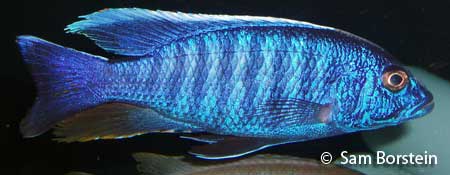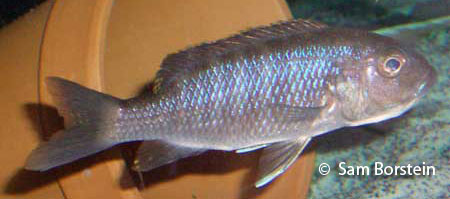Sciaenochromis fryeri
Konings, 1993
Electric Blue Haplochromis
Synonyms: Haplochromis ahli (different species), Haplochromis fryeri, Sciaenochromis ahli (diferent species, same as Haplochromis ahli)

Above: A male Electric Blue. Photo by Sam Borstein.
Etymology:
Genus- Sciaena= sea (Latin), chromis= a fish, perhaps a perch (Latin).
Species- fryeri= Named after Geoffrey Fryer.
Intro:
Scianochromis fryeri is a spectacular Malawi Hap. This fish is a mainstay in the hobby because it is readily available, easy to care for, and is striking in color. This fish comes in a variety of location variants with the most popular being the Marleri Island, also known as the Ice Berg Freyeri.
Male Scianochromis fryeri are a beautiful light shiny blue. Depending on location variants the fish may have a blaze and some color in the fins. Faint bars are occasionally seen on the body. Females are gray with a little blue sheen.
This fish is different than Scianochromis ahli, although commonly confused. Many Scianochromis fryeri are sold as Scianochromis ahli or Hap Ahlis when Hap Ahlis are sporadically imported into America. True Scianochromis ahli have almost no color, much larger eyes, and a point at the bottom of their lower jaw. they also have many more individual egg spots on their anal fin than Scianochromis fryeri.
Distribution:
This fish is found at many locations in Lake Malawi in the intermediate habitat.
Size, Maturity, and Sexual Dimorphism:
Size: Males- 8 inches, Females- 6 inches
Maturity: 3 inches
Sexual Dimorphism: Males are larger than females, and are a lot more colorful than the females which are gray. Males will start showing color at 2 inches and will really show color at 3-3.5 inches.
Care:
Electric Blues are a docile fish. They will not harm any other species of tank mate. The only time I ever witnessed aggression was during spawning, and it is minimal then. Electric Blues are best kept in trios or quads with only one male, and multiple females. A young trio or quad (3-4 inches) can easily be put in a 40 breeder and an older trio or quad in a 75-125 gallon tank.
Diet:
Electric Blues are piscivores in the wild and feed using two very unique techniques (Konings, 2007).
Electric Blues pretend to pick at the algae to make themselves look like an mbuna, a non threatening fish. When a smaller fish comes close enough thinking it is not a predator, it lunges at it and grabs it.
Another technique is hanging around the nest of the Kampongo Catfish (Bagrus meridionalis) native to Malawi. Many female cichlids release their fry over the Kampango nests to provide refuge for their fry. The Kampango is a large catfish and very protective. It will eat anything deemed threatening to its fry. The Electric blue hang out around the nests and ambush the fry that seek protection from the Kampango. The Kampango don't attack the Sciaenochromis fryeri because the pose no threat to their fry.
In the aquarium, Electric Blues are not picky eaters and will eat almost anything. I've had success feeding them HBH and Tetra flake foods as well as spectrum.
Breeding:
Electric Blues are no challenge to breed. Males will have even more intense colors when spawning. The male will take over a breeding territory, and then display to a female. The female will lay an egg, pick it up, and it will be fertilized in her mouth.
Electric Blues are good holders. At 20-24 days the fry are almost completely developed, and almost free swimming. I recommend stripping the fish at this time. Fry are large and numerous. One of my spawns contained 65 fry. It is good to start them off on baby brine, but if over fed, the fish will over eat and "pop". As soon as they are able to take flake, I recommend switching them over. Fry grow at a good pace.

Above: A female Electric Blue holding. Photo by Sam Borstein.
Conclusion:
This beautiful fish is a great addition to any show tank. If you are just starting with cichlids, I also recommend this fish. Easy to keep and breed.
References:
- Konings, A. (2007) Malawi cichlids in their natural habitat. 4th ed., Cichlid Press, El Paso, Texas, 424 pp.
